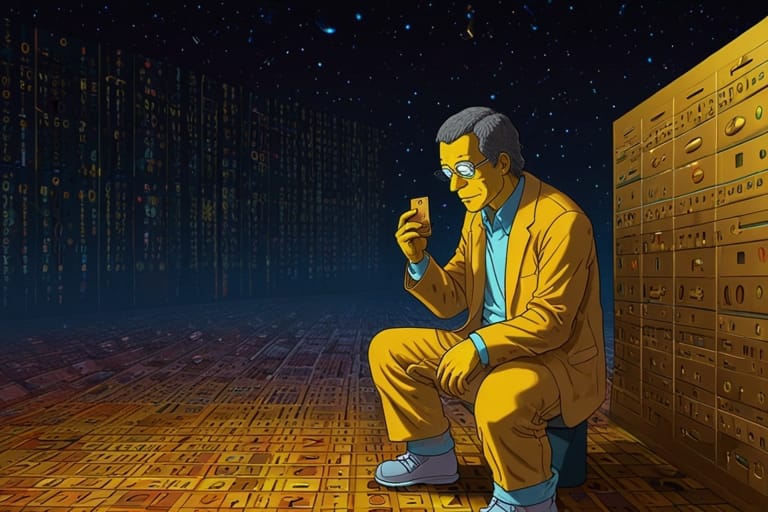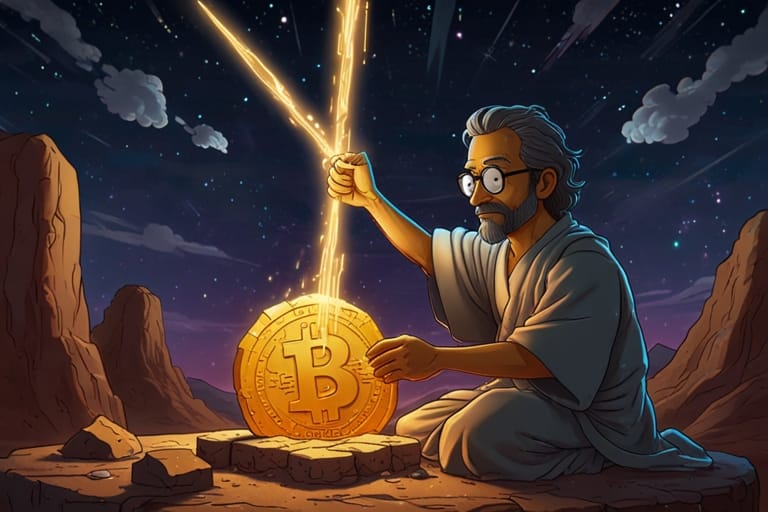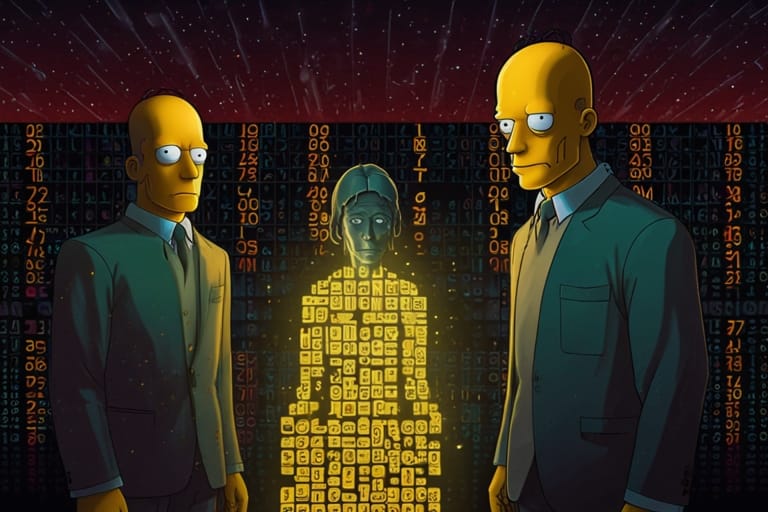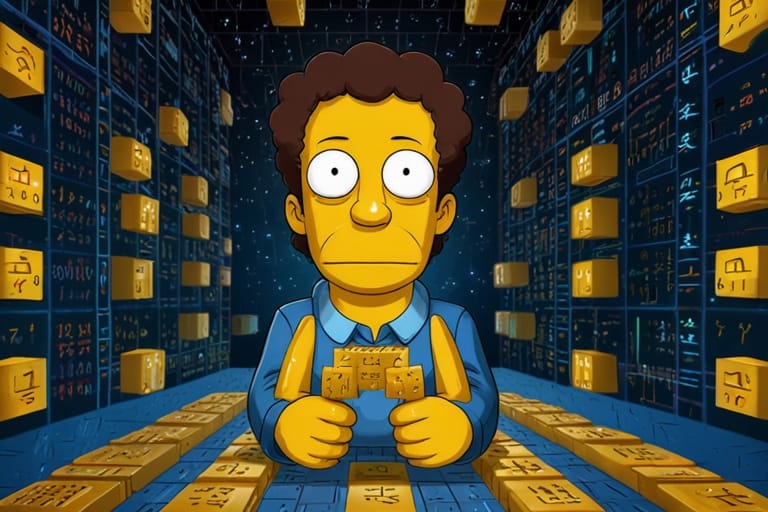Bitcoin as a Decentralized Time Capsule and Cultural Artifact🟡 Decoding Bitcoin Embedded Messages

Hello Springfield! Today’s topic? The greatest starting line of any story ever told: Bitcoin’s Genesis Block, also known as Block 0. Think of it as the “Once upon a time…” of financial sovereignty. Except, instead of fairy godmothers, we got cryptographic proof, and instead of pumpkins, we got...well, the collapse of traditional banks.
📰 January 3, 2009
The global financial system is still smoking from the dumpster fire of 2008. While Homer Simpson is probably using his government bailout check on Duff Beer, somewhere in the shadows, a mysterious figure, or group, named Satoshi Nakamoto hits "Enter" and creates the first-ever Bitcoin block. Block 0 is born, kicking off the blockchain revolution.

Unlike the endless doughnut-shaped loops of fiat systems, the Genesis Block has two unique characteristics:
- It Can’t Be Spent. No one can access the 50 BTC reward tied to it. Satoshi basically said, “These coins are off-limits. Forever.”
- It Has a Message. And not just any message. It’s the blockchain equivalent of graffiti on a bank’s wall:
“The Times 03/Jan/2009 Chancellor on brink of second bailout for banks.”
The message screams: "Bank bailouts are a problem. Let’s try something new". It’s the first and most iconic political statement encoded in Bitcoin’s history, setting the tone for everything that followed.
🔗 Explore the Genesis Block on Blockchair
🤔 How Did Satoshi Do It?
Technically speaking, Satoshi embedded the headline using a hash in the coinbase parameter of the block’s transaction. If that sounds like gibberish, don’t worry. Think of it as scribbling a note on a dollar bill—but digital and unforgeable. Genius, right? And thus, Bitcoin was born: decentralized and with zero need for banks. Eat that, Mr. Burns!
📝 A Growing Library
Block 0 wasn’t just a tech innovation; it opened Pandora’s box for future Bitcoin graffiti. The blockchain isn’t just for transactions—people have been using it to store messages for eternity. Want to declare your love? Publish your manifesto? Share a cat meme in ASCII? The blockchain’s got you covered. And because this is Bitcoin, no one can erase it. Ever.

Deciphering these messages isn’t just about technical fun. They’re a time capsule of Bitcoin’s history, showcasing everything from love notes to political manifestos. By learning to decode them, you’re connecting directly with the blockchain's rich cultural tapestry.
Here’s a guide to uncovering these blockchain Easter eggs:
🛠️ How to Decipher Messages in Bitcoin Transactions
- Identify the Block or Transaction:
Every message resides within a specific block or transaction. Start with the block number (e.g., the Genesis Block is Block 0) or a transaction ID (TXID). - Use a Blockchain Explorer:
Tools like Blockchair, BTCScan, or Mempool allow you to search for specific blocks or transactions. Paste the block height or TXID into their search bar. - Locate the Coinbase Field or OP_RETURN Output:
- Coinbase Field: For messages like the Genesis Block’s, you’ll need to look at the coinbase parameter in the block's metadata. Blockchain explorers usually display this field prominently.
- OP_RETURN Field: In transactions with embedded data, the OP_RETURN field contains the message. It’s easy to spot in the transaction details as it’s marked separately.
- Decode the Hexadecimal Data:
Most messages are stored in hex format, which looks something like this:5468652054696d65732030332f4a616e2f32303039204368616e63656c6c6f72206f6e206272696e6b206f66207365636f6e64206261696c6f757420666f722062616e6b73.- Use any hex-to-text converter (many are available online for free). Copy the hex string and convert it to plain text to reveal the message.
🔍 Example: Decoding the Genesis Block’s Message
Here’s how to reveal the infamous message from Block 0:
- Go to the Genesis Block on Blockchair.
- Look at the coinbase field in the transaction details.
- Decode the hex string using an online tool like RapidTables.
The result will read: "The Times 03/Jan/2009 Chancellor on brink of second bailout for banks."

🖋️ Tips for Finding Other Messages
- Use the term "OP_RETURN" in blockchain explorers to filter transactions containing messages.
- Look for curated lists of known Bitcoin messages, such as bitinfocharts or discussions on Bitcoin forums.
- For ASCII art and longer encoded texts, you might need more advanced tools like Python scripts that parse raw blockchain data.
🔎 Curious Messages Found on Bitcoin Transactions
Let’s dive into a few real-life examples of this blockchain library in action. Some are hilarious, some poignant, and others...well, you be the judge:
- Marriage Proposal: In 2014, someone used Bitcoin to propose. Forget diamonds—blockchain is forever. 💍
🔗 Block 123456 - "HODL!" Motivational Speech: Found in Block 420,000, a hodler reminded us all to keep calm and stack sats.
🔗 Block 420,000 - ASCII Art: From cats to alien faces, you name it, it’s probably somewhere in the blockchain.
🔗 Sample Block - Political Rants: Plenty of messages against censorship and for freedom, like “Free Assange.”
🔗 Block 789012 - Easter Eggs in Code: Developers love leaving cryptic clues, like treasure hunts for nerds.
⚒️ How Do You Embed Messages in Bitcoin?
Good question! Bitcoin transactions allow users to include extra data in the OP_RETURN field. This field can store up to 80 bytes of information—perfect for short messages, hashtags, or even memes. Of course, it comes with costs: using block space for messages means fewer transactions can fit in each block.
So, why do people do it? Because “just because you can” is a core philosophy of the internet—and apparently, Bitcoiners, too.

🚨 Is Storing Messages Controversial?
You betcha. Critics argue that these messages bloat the blockchain and increase storage requirements for nodes. Others see it as an essential part of Bitcoin’s cultural history. After all, without weirdness, is it even Bitcoin?
🧠 The Philosophical Side: Bitcoin as Memory
When you think about it, Bitcoin isn’t just a currency. It’s a decentralized time capsule. Unlike Homer's memory (which seems to reset every episode), Bitcoin’s memory is permanent. Every message tells a story, whether it’s about resistance, hope, or simply a love for donuts.
Imagine aliens discovering the blockchain centuries from now:
"So these humans fought banks with cryptographic money, left ASCII cats in their transactions, and kept yelling HODL. Fascinating species."
🌟 Conclusion: Bitcoin as a Cultural Artifact
The Genesis Block was more than the start of a decentralized ledger. It was the opening act of a revolution, complete with Easter eggs and a sense of humor. Satoshi didn’t just build a payment network; they gave us a way to communicate, to create, and to immortalize messages in the digital ether.

So next time you’re sending sats, think of the Genesis Block. Think of the boldness it took to challenge the system. And maybe, just maybe, include a little message of your own. Who knows? It might be the next thing a nerdy alien writes a thesis on.
Stay decentralized, stay weird, and don’t forget to eat a donut today. 🍩🚀
SatoshiPlanet, out!
Tips are welcome
Bitcoin Native Segwit: bc1qmlcc9qdkcrzeph0tnnrpf7qk27f5l74897zpq9
Lightning Network: satoshiplanet@stacker.news // satoshiplanet@zbd.gg
Ordinals, Runes, and BRC-20 tokens : bc1pg0d9knv65g0qwzak4t4dcumgce7xvqv6e4d36m8t7mtap6epr9vqmerqz5
Stacks NFTs & SIP-10 tokens: SPNQYZ5G9SWH5639C6GEMNMXJH48ETV34D8SMCVA